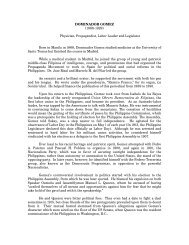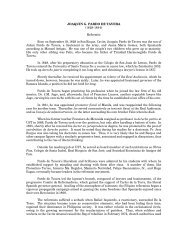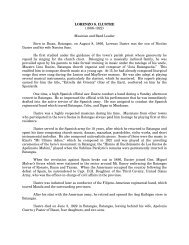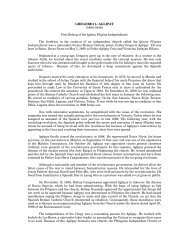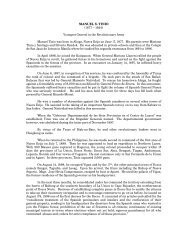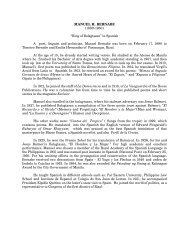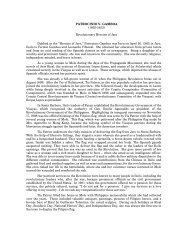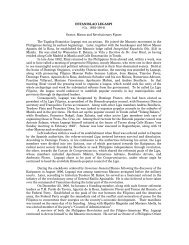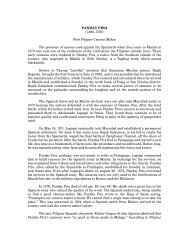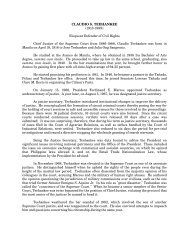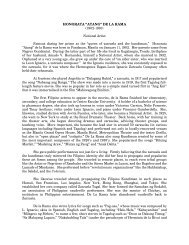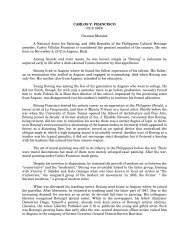GREGORIA P. MONTOYA (1863-1896) “Henerala” of the Revolution ...
GREGORIA P. MONTOYA (1863-1896) “Henerala” of the Revolution ...
GREGORIA P. MONTOYA (1863-1896) “Henerala” of the Revolution ...
You also want an ePaper? Increase the reach of your titles
YUMPU automatically turns print PDFs into web optimized ePapers that Google loves.
<strong>GREGORIA</strong> P. <strong>MONTOYA</strong><br />
(<strong>1863</strong>-<strong>1896</strong>)<br />
<strong>“Henerala”</strong> <strong>of</strong> <strong>the</strong> <strong>Revolution</strong><br />
Gregoria Montoya was a native <strong>of</strong> sitio Batong Dalig, barrio Tabon, Kawit, Cavite. She was<br />
born on November 28, <strong>1863</strong> to a farming couple - Atanario Montoya and Jacoba Patricio.<br />
Montoya grew up to be an iron-willed woman with an unusual physical strength.<br />
Montoya married Cirilo Ayson, a Chinese mestizo. He died after six years <strong>of</strong> marriage,<br />
leaving her with <strong>the</strong>ir four sons – Pedro, Patricio, Marino, and Francisco. The last three died later.<br />
After five years <strong>of</strong> widowed life, she took on ano<strong>the</strong>r man, Pedro Cacpal, who was a match for her<br />
in strength. They lived as man and wife out <strong>of</strong> wedlock and had a son named Juan Montoya. He<br />
was two-years old when <strong>the</strong> revolution broke out in <strong>1896</strong>.<br />
Gregorio Montoya signed up with <strong>the</strong> Magdalo faction <strong>of</strong> <strong>the</strong> Katipunan on August 31 <strong>of</strong><br />
that year.<br />
The day after her affiliation, she participated in <strong>the</strong> capture <strong>of</strong> our guardia civil in Kawit.<br />
The following day, she headed a Magdalo faction in <strong>the</strong> battle <strong>of</strong> Imus, where 13 arms were<br />
captured from <strong>the</strong> enemy. On <strong>the</strong> third day, heavy fighting took place in Bacoor, with General<br />
Aguinaldo himself commanding <strong>the</strong> rebel troops.<br />
Montoya’s physical strength became known to <strong>the</strong> revolutionaries after Aguinaldo ordered<br />
her to lead a team <strong>of</strong> Katipuneros to destroy a wooden bridge across <strong>the</strong> Mabolo River, which<br />
separated Binakayan, Kawit, from Bacoor, Cavite. General Blanco, who was determined to quell<br />
<strong>the</strong> Cavite uprising, had left Manila for Bacoor on November 7, <strong>1896</strong> at <strong>the</strong> head <strong>of</strong> a large<br />
contingent <strong>of</strong> mixed Spanish and Filipino troops. Thus, Binakayan assumed a highly strategic<br />
importance. Montoya’s unit was given <strong>the</strong> task <strong>of</strong> delaying <strong>the</strong> advance <strong>of</strong> Blanco’s troops by<br />
dismantling <strong>the</strong> Mabolo Bridge.<br />
The wooden planks across <strong>the</strong> bridge had already been removed one by one, and what<br />
remained were <strong>the</strong> thick and sturdy beams, each measuring about 40 feet long. To her soldier’s<br />
amazement, Montoya single-handedly raised one end <strong>of</strong> a beam while several men held onto <strong>the</strong><br />
o<strong>the</strong>r end, and <strong>the</strong>n threw it into <strong>the</strong> river.<br />
Montoya was aid to be a favorite trouble-shooter <strong>of</strong> General Aguinaldo, who ordered her<br />
several times to respond to calls for help from o<strong>the</strong>r battle sectors.<br />
On November 10, <strong>1896</strong>, she led a force <strong>of</strong> 30 Magdalo men, including Hermogenes<br />
Saguilayan, a bandit leader, to Noveleta. It was reinforcement for Katipuneros, under <strong>the</strong> overall<br />
command <strong>of</strong> Colonel Luciano San Miguel, facing <strong>the</strong> Spanish troops headed by General De Los<br />
Rios.<br />
On <strong>the</strong> open field <strong>of</strong> Calero, Noveleta, close to <strong>the</strong> beach <strong>of</strong> Dalahican, Montoya stood on<br />
top <strong>of</strong> a battery, one hand holding <strong>the</strong> Katipunan flag al<strong>of</strong>t and ano<strong>the</strong>r hand clasping a bolo. In<br />
<strong>the</strong> ensuing battle, she was hit by cannonball, fired from a Spanish navy boat <strong>of</strong>f Dalahican beach,<br />
right in her midsection.<br />
It remains unclear whe<strong>the</strong>r Gregoria, like Agueda Kahabagan was awarded posthumously<br />
<strong>the</strong> title <strong>of</strong> Generala. However, in her memory, <strong>the</strong> people <strong>of</strong> Kawit have named a street “Gregoria”<br />
in her native barrio <strong>of</strong> Tabon.
References:<br />
Alvarez, Santiago V. The Katipunan and <strong>the</strong> <strong>Revolution</strong>: Memoirs <strong>of</strong> a General. Quezon City:<br />
Ateneo de Manila University Press, 1992.<br />
Soriano, Rafaelita. Women in <strong>the</strong> <strong>Revolution</strong>. Quezon City: Printon Press, 1995.<br />
NHI Publication, Unsung Heroes




